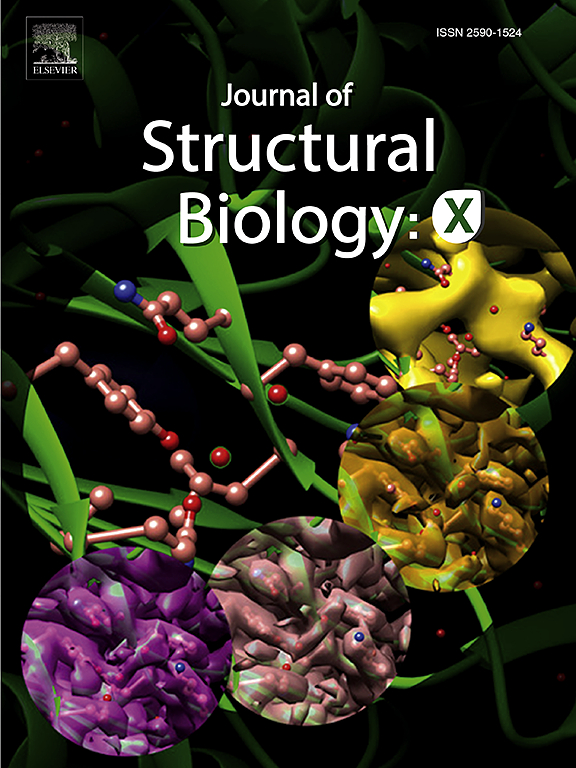Determinants of site-selectivity in human ileal bile acid-binding protein by NMR dynamic analysis of a functionally-impaired mutant
IF 2.7
3区 生物学
Q3 BIOCHEMISTRY & MOLECULAR BIOLOGY
引用次数: 0
Abstract
Human ileal bile acid-binding protein (hI-BABP), a member of the family of intracellular lipid-binding proteins, has a key role in the enterohepatic circulation of bile salts. The two internal binding sites of hI-BABP exhibit positive cooperativity accompanied by a site preference of glycocholate (GCA) and glycochenodeoxycholate (GCDA), the two most abundant bile salts in the human body. Previous study of Q51A hI-BABP in its apo state, a mutant with lost site-selectivity, suggests that disruption of the hydrogen-bonding network in the vicinity of the C/D-turn has long-range dynamic effects. To improve our understanding of the determinants of site-selectivity in hI-BABP, a comparative NMR chemical shift and spin relaxation analysis of homo- and heterotypic bile salt complexes of wild-type and Q51A hI-BABP was carried out. The wild-type GCDA-complex shows a striking similarity with the thermodynamically most stable hI-BABP:GCDA:GCA complex in terms of both structure and dynamic behaviour, suggesting that the bound GCDA at site 1 has a decisive role in conveying key stabilizing interactions in the physiologically most abundant heterotypic complex. Destabilization of hI-BABP-GCDA by the functionally impairing mutation Q51A is indicated by both the increase of ms-timescale motions in key segments of the protein as well as by increased ps-ns local fluctuations superimposed on slow motions. Our study suggests that binding interactions in hI-BABP might be modulated by altering the dynamic behaviour of specific segments in the protein with implications for targeting the intracellular trafficking of bile salts and bile salt-induced stimulation of nuclear receptors.

人类回肠胆汁酸结合蛋白位点选择性的决定因素:功能受损突变体的核磁共振动态分析
人回肠胆汁酸结合蛋白(hI-BABP)是细胞内脂质结合蛋白家族的一员,在胆盐的肠肝循环中起关键作用。hI-BABP的两个内部结合位点表现出积极的协同作用,并伴有糖胆酸盐(GCA)和糖鹅脱氧胆酸盐(GCDA)的位点偏好,这是人体中最丰富的两种胆汁盐。先前对失位选择性突变体Q51A hI-BABP载脂蛋白状态的研究表明,C/D-turn附近氢键网络的破坏具有长期动态影响。为了进一步了解hI-BABP中位点选择性的决定因素,我们对野生型和Q51A型hI-BABP的同型和异型胆盐配合物进行了核磁共振化学位移和自旋弛豫对比分析。野生型GCDA复合物在结构和动力学行为方面与热力学上最稳定的hI-BABP:GCDA:GCA复合物具有惊人的相似性,这表明在生理上最丰富的异型复合物中,1位点结合的GCDA在传递关键的稳定相互作用方面起着决定性作用。功能受损突变Q51A破坏了hI-BABP-GCDA的稳定性,表明该蛋白关键片段的ms-时间尺度运动增加,以及缓慢运动上叠加的ps-ns局部波动增加。我们的研究表明,hI-BABP中的结合相互作用可能通过改变蛋白质中特定片段的动态行为来调节,这意味着靶向细胞内胆盐运输和胆盐诱导的核受体刺激。
本文章由计算机程序翻译,如有差异,请以英文原文为准。
求助全文
约1分钟内获得全文
求助全文
来源期刊

Journal of structural biology
生物-生化与分子生物学
CiteScore
6.30
自引率
3.30%
发文量
88
审稿时长
65 days
期刊介绍:
Journal of Structural Biology (JSB) has an open access mirror journal, the Journal of Structural Biology: X (JSBX), sharing the same aims and scope, editorial team, submission system and rigorous peer review. Since both journals share the same editorial system, you may submit your manuscript via either journal homepage. You will be prompted during submission (and revision) to choose in which to publish your article. The editors and reviewers are not aware of the choice you made until the article has been published online. JSB and JSBX publish papers dealing with the structural analysis of living material at every level of organization by all methods that lead to an understanding of biological function in terms of molecular and supermolecular structure.
Techniques covered include:
• Light microscopy including confocal microscopy
• All types of electron microscopy
• X-ray diffraction
• Nuclear magnetic resonance
• Scanning force microscopy, scanning probe microscopy, and tunneling microscopy
• Digital image processing
• Computational insights into structure
 求助内容:
求助内容: 应助结果提醒方式:
应助结果提醒方式:


